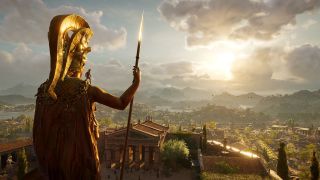
The first, natural response to sinking a bunch of cash into a new graphics card is to test it with the best looking and most demanding games. But the age of Crysis being the default go-to for testing new gaming hardware has long since passed, so what are the flashiest games of this generation to showcase a GPU?
As it turns out, there are a lot of great options. I've jumped into all of the current generation's most graphically intense titles to find the ones that will really stress test your rig, and let you show your less tech savvy friends and family how absolutely incredible modern video games can look when powered by the right machine. And while all these games are incredible looking as unified works, I also looked for engines that integrate or made exceptional use of some specific technique or tone.
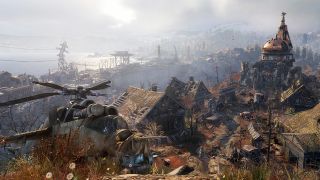
The Metro franchise has always been visually impressive, but liberating it from the stagnant tunnels of the Russian subway system has really opened up the palette for the artists at 4A Games. Set on the barren tundra and in the sun parched desert of the Metro universe's post-apocalypse, Exodus is an incredible example of what's possible when a huge team of very capable devs is set loose on some of the most impressive technology.
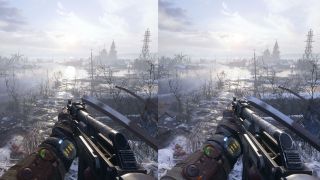
Ray tracing is enabled in the right image, where the effect is most noticeable in bright reflections on water and snow
The setting and characters are undeniably beautiful and, perhaps most interesting, Exodus is only the second modern game to fully take advantage of Nvidia's 20-series of cards, with their specialized cores designed to implement real time ray tracing as well as the machine-learning-powered anti-aliasing technique, DLSS. If you've got a DXR-ready card, you'd be doing yourself a disservice by not grabbing Metro - the difference between ray traced and non-ray traced sequences is subtle but powerful, especially in instances like the one above, where light is being dynamically reflected off the moving surface of the water.
Our review | Pre-order now
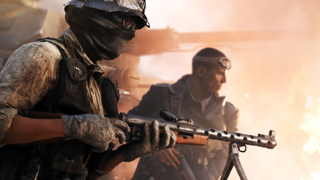
Battlefield V is an exceptional looking game, with gorgeous environments, realistic faces and character models, and amazing fire effects. But the real reason to lean on it to demo your new video card is that it's one of only two modern games (not counting Quake 2) that currently take advantage of ray tracing technology, which if you've spent a bunch of money on one of Nvidia's 20-series cards makes it borderline mandatory.

Enabling ray tracing (right) allows developers to reflect off-screen parts of a scene
Ray tracing attempts to simulate the way rays of light interact with objects in a virtual environment and as such it affects everything from shadows to reflections. Toggling it on in Battlefield generally makes a subtle but noticeable difference and adds an overall sensation of depth and detail, especially in areas with complex lighting and multiple light sources. In some instances, however, like the comparison screenshot above drawn from a Nvidia tech demo, the possibilities are much more dramatic.
Unlike traditional screen space reflection, ray tracing allows developers to reflect parts of a scene that aren't currently being displayed on the screen, like the explosive off-screen muzzle report from a tank reflected in the side panel of the car in the screenshot. It also means that reflections on complex surfaces, like the flame dappling the ruined car's dented chassis, are simulated in a more complex and realistic way. A February 12th patch promises to improve ray tracing performance and, more importantly, adds DLSS support to Battlefield 5. If you've got an RTX card, Battlefield V will let you feel just that little bit more justified in your (likely pretty expensive) purchase.
Our review | Buy it now
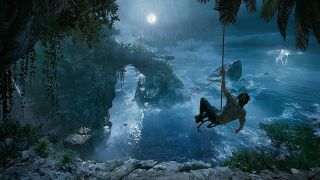
Maybe you've opted to go the Radeon VII route instead, though, or maybe you're just exhausted by the blood drenched mud of WWII battlefields or aren't interested in Metro's post-apocalyptic Russian frontier. A fantastic alternate option (and one that will reportedly eventually get ray tracing patched in) is Crystal Dynamic's Shadow of the Tomb Raider, which blends a number of impressive techniques to produce one of the best looking games currently available. As an added bonus, it includes a built-in benchmarking utility, so you can fully quantify just how powerful your new card is.
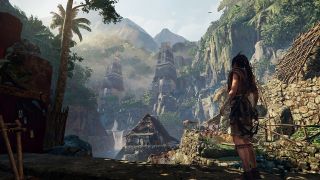
One of SotTR's countless densely detailed environments cast in vivid contrast in part thanks to expert use of HDR
SotTR makes excellent use of techniques like tessellation and HDR to render detailed environments ranging from dense jungles, pulsing and crawling with verdant life, to crumbling moss-covered ruins that look so real you can practically smell the must. Tessellated surfaces are packed with increased geometric detail, which enhances the realism and complexity of textures, particularly when ambient occlusion causes layered shadows to fall across an object, highlighting raised or recessed areas. It's a high mark in a series that's rightly known for its gorgeous visuals, and just the sort of graphical treat to toss down the hungry gullet of a new GPU.
Our review | Buy it now

Most of the games on this list are first or third person action games for obvious reasons, but they don't have a monopoly on amazing graphics. While the majority of strategy titles aren't exactly renowned for their incredible visuals, games like Total War: Warhammer II demonstrate that it's not just shooters that feature visual flash.
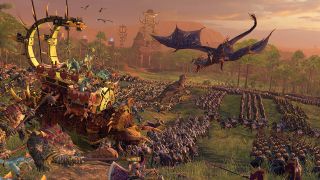
One of Warhammer 2's battlefields, dense with combatants and fantasy monsters
It's the massive fantasy battles that stand out, of course, visually stunning set pieces sprawling across the threshold of towering mountain fortresses or meandering across rolling foothills and tree-dotted plains. The scale of these battles is awe-inspiring, particularly when they see more than two armies clashing, and watching countless thousands of soldiers collide like waves of black-metal-clad flesh can be truly hair raising.

Warhammer 2's lush, gorgeous metalayer
But it's not just the battles; the overworld map, especially since the release of the Mortal Empires update that brought the entirety of the Warhammer Fantasy world to the game, is rendered in beautiful detail, with wisps of fog blowing across haunted mountain passes, and dark cliffs of blasted stone jutting menancingly from the Chaos-infested earth. Warhammer 2 is a visual feast even when orc hordes aren't crashing over elven pike lines, and like Shadow of the Tomb Raider it comes with its own handy benchmarking utility.
Our review | Buy it now
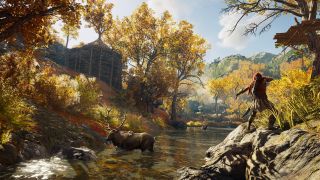
More than the best looking entry in the Assassin's Creed franchise, Odyssey is one of the most visually sumptuous games ever released. It's a masterpiece of art design and technical implementation fused into a gorgeous, harmonious whole, the apex of beautiful craft brought to life through digital sorcery. The Greek world is a jewel that the game takes full advantage of to render a diverse set of environments as the backdrop to brutal assassinations and epic naval clashes.
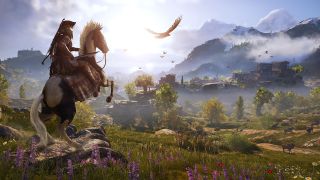
Odyssey's sprawling setting offers seemingly endless vistas
The massive open world Odyssey presents is a great way to stress your card's draw distance capabilities, and the blend of huge environments (with generous lines of sight) and extremely sharp detail at close range is also a great way to showcase your hardware's LOD rendering. The only minor quibble I have with Odyssey's technical implementation is that the cloth animations on character models are capped at 30 FPS which can make character movement look slightly odd if the rest of the game is running at a higher frame rate, but you're unlikely to notice, especially whilst hypnotized by the staggering natural beauty of Ancient Greece.
Our review | Buy it now
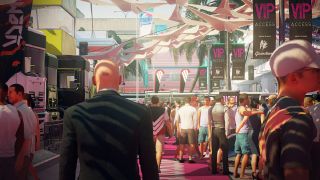
The first of the Hitman reboot games was nice enough looking, but the sequel really pushes the series visuals to their logical extreme, in large part by stretching their Glacier 2 engine's legs in locales like an open-wheel race in sunny Miami or the densely crowded streets of Mumbai. The combination of these beautiful settings combined with a deft touch with a couple of advanced graphic techniques elevates Hitman's looks up to the level of its remarkable gameplay.
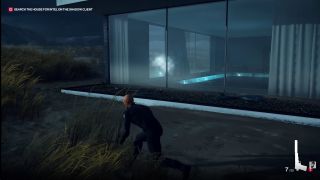
HItman 2's reflection tech at work
In particular, Hitman 2's much advertised reflection tech is really impressive. An early example of this is the prologue level, where Agent 47 is approaching a remote luxury home with high glass walls. Expertly blended with the shifting interior view as you approach is a high-fidelity reflection of the midnight sky and exterior world, including the protagonist. It's stunning, and even has gameplay implications if an enemy spots you in a mirror slinking up behind them. It's also just the tip of an impressive (ahem) glacier of techniques, from their incredible dynamic crowd modeling to the use of parallax occlusion to add depth and detail to surface textures. Welded together they create a gestalt that makes the clockwork world of Hitman 2 incredibly immersive.
Our review | Buy it now
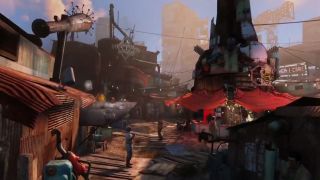
One of the recent milestones when evaluating new GPUs is how well they're able to handle VR, which is notoriously demanding because it requires a PC to simultaneously output two images at identical resolution. Stereoscopic rendering is difficult under the best of circumstances, and when applied to a game as complex as Fallout 4 is extremely challenging without performance plummeting.
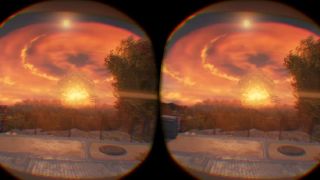
VR requires graphics to be rendered in split screen stereo, meaning each scene must be fully rendered twice
Now sporting native Vive and Rift support, Fallout 4 VR is a great way to stress test a card under some of the most demanding circumstances - framiness or stuttering in VR isn't just an annoyance, it can be seriously physically discomfiting. Fallout 4 may be a couple years old now, but the Commonwealth Wasteland still looks beautiful (and pleasantly colorful, for a Fallout game), especially when rendered in glorious VR.
Our review (Fallout 4) | Buy it now






0 comentários:
Postar um comentário